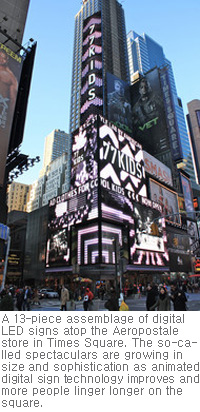 Tourists Abet Digital Signs in Times Square’s Urban Mall
Tourists Abet Digital Signs in Times Square’s Urban Mall
The wandering throngs in Times Square point their mobile phones and digital cameras at the 230 flickering signs that ascend more than 20 stories over New York City’s central public square.
It’s a head-on collision between 350,000 daily pedestrians and 385,000 square feet of saturated color.
The signs on Times Square grow larger and climb higher than ever as digital technology has transformed both the displays and the way people use this elongated bowtie intersection.
The area once was known for billboard artifice. There are still a few holdouts, such as a fabric banner promoting the Broadway show “Mary Poppins” that rises 26 stories.
Now much of the square is a “mediascape.” I first encountered this by crashing into a swirling crowd that had screeched to a halt to stare at a giant digital sign that showed us staring back.
We waved and clicked camera phones at our pixelated selves waving and clicking.
I returned to that sign with Jason Barak, managing partner of D3led LLC, which designed and fabricated this and most of the square’s proliferating digital “spectaculars” (as the trade calls them). It surmounts a Forever 21, a youth-oriented fashion retailer.
D3led framed the storefront in pink LED strips. The numerals 21 projected forward from the sign, creating a ghostly image layered over the street image. Sometimes a video figure danced “into” the waving throngs, appearing to interact with the real people caught on video -- artifice atop artifice.
Square Foot Cost
Barak wouldn’t tell me what this extravaganza cost. But he said the signs range from $500 to $2,000 a square foot, depending largely on the screen resolution.
He’s proudest of the 17,000 square feet of animated electronic signage that runs in broad diagonal bands down the Times Tower, the landmark 22-story flatiron building that dominates the southern end of the square.
Digital technology is not the only reason people linger in the square. The discount ticket booth called TKTS was replaced in 2008 with a glass-enclosed new structure roofed in a set of red-lit steps. It offers a perfect photo op, along with cheaper tickets.
Then city officials set aside large swaths of roadway for pedestrians, diverting traffic elsewhere. Cafe tables and chairs sprouted.
‘Dwell Time’
Retailers balked, but pedestrian-friendly Times Square has been a hit with visitors. Marketers saw peoples’ “dwell time” increase and rushed to take advantage.
Animators made M&Ms dance, spin and explode. Signs urged visitors to dial-in their designs for an athletic shoe on their phones, and watch their alterations appear in blinking diodes. Advertisers tied their electronic messages to live performances on the square.
Visitors pitch in by shooting photos and videos, and posting them on Facebook (FB) and YouTube. Gadgetry brings more people out to look at actual Broadway dancers.
The Times Square Alliance, a business-improvement district, is working on “Midnight Moment,” which would bring short artist- generated animations to play across dozens of screens.
For decades neon-light girls have danced above the square. A Camel cigarette sign breathed smoke. Pepsi bottles posed atop fizzing waterfalls.
Aesthetes correctly deem the square a mall. Yet the inventiveness of sign makers has kept the canyonlike streets of Times Square a throbbing urban nexus.
(James S. Russell writes on architecture for Muse, the arts and culture section of Bloomberg News. He is the author of “The Agile City.” The opinions expressed are his own.)
 Tourists Abet Digital Signs in Times Square’s Urban Mall
Tourists Abet Digital Signs in Times Square’s Urban Mall